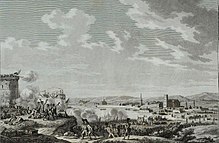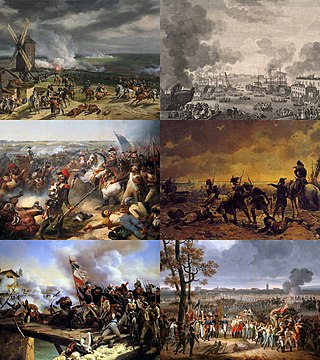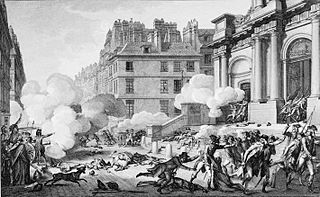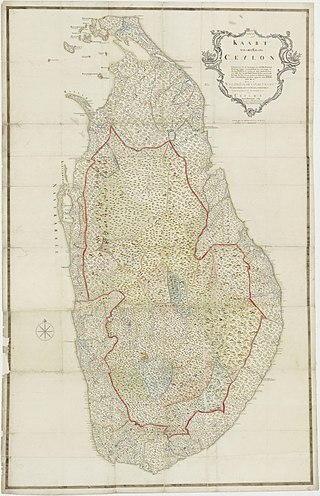| |||||
| Decades: | |||||
|---|---|---|---|---|---|
| See also: | Other events of 1795 History of France • Timeline • Years | ||||
This article needs additional citations for verification .(June 2022) |
Events from the year 1795 in the French First Republic .
| |||||
| Decades: | |||||
|---|---|---|---|---|---|
| See also: | Other events of 1795 History of France • Timeline • Years | ||||
This article needs additional citations for verification .(June 2022) |
Events from the year 1795 in the French First Republic .



The 1790s was a decade that began on January 1, 1790, and ended on December 31, 1799. Considered as some of the Industrial Revolution's earlier days, the 1790s called for the start of an anti-imperialist world, as new democracies such as the French First Republic and the United States began flourishing at this era. Revolutions – both political and social – forever transformed global politics and art, as wars such as the French Revolutionary Wars and the American Revolutionary War moulded modern-day concepts of liberalism, partisanship, elections, and the political compass.

1795 (MDCCXCV) was a common year starting on Thursday of the Gregorian calendar and a common year starting on Monday of the Julian calendar, the 1795th year of the Common Era (CE) and Anno Domini (AD) designations, the 795th year of the 2nd millennium, the 95th year of the 18th century, and the 6th year of the 1790s decade. As of the start of 1795, the Gregorian calendar was 11 days ahead of the Julian calendar, which remained in localized use until 1923.

The Directory was the governing five-member committee in the French First Republic from 26 October 1795 until 10 November 1799, when it was overthrown by Napoleon Bonaparte in the Coup of 18 Brumaire and replaced by the Consulate. Directoire is the name of the final four years of the French Revolution. Mainstream historiography also uses the term in reference to the period from the dissolution of the National Convention on 26 October 1795 to Napoleon's coup d’état.

The War of the First Coalition was a set of wars that several European powers fought between 1792 and 1797 initially against the constitutional Kingdom of France and then the French Republic that succeeded it. They were only loosely allied and fought without much apparent coordination or agreement; each power had its eye on a different part of France it wanted to appropriate after a French defeat, which never occurred.

Jean-Charles Pichegru was a French general of the Revolutionary Wars. Under his command, French troops overran Belgium and the Netherlands before fighting on the Rhine front. His royalist positions led to his loss of power and imprisonment in Cayenne, French Guiana during the Coup of 18 Fructidor in 1797. After escaping into exile in London and joining the staff of Alexander Korsakov, he returned to France and planned the Pichegru Conspiracy to remove Napoleon from power, which led to his arrest and death. Despite his defection, his surname is one of the names inscribed under the Arc de Triomphe, on Column 3.

The following is a timeline of the French Revolution.

The French Revolutionary Wars were a series of sweeping military conflicts lasting from 1792 until 1802 and resulting from the French Revolution. They pitted France against Britain, Austria, Prussia, Russia, and several other monarchies. They are divided in two periods: the War of the First Coalition (1792–1797) and the War of the Second Coalition (1798–1802). Initially confined to Europe, the fighting gradually assumed a global dimension. After a decade of constant warfare and aggressive diplomacy, France had conquered territories in the Italian Peninsula, the Low Countries and the Rhineland. French success in these conflicts ensured the spread of revolutionary principles over much of Europe.
The French Revolutionary Wars continued from 1794 between Revolutionary France and the First coalition.

The Chouannerie was a royalist uprising or counter-revolution in twelve of the western départements of France, particularly in the provinces of Brittany and Maine, against the First Republic during the French Revolution. It played out in three phases and lasted from spring 1794 to 1800.

13 Vendémiaire, Year 4 in the French Republican Calendar, is the name given to a battle between the French Revolutionary troops and Royalist forces in the streets of Paris. This battle was part of the establishing of a new form of government, the Directory, and it was a major factor in the rapid advancement of Republican General Napoleon Bonaparte's career.
Events from the year 1646 in England. This is the fifth and last year of the First English Civil War, fought between Roundheads (Parliamentarians) and Cavaliers.

Quiberon Bay is an area of sheltered water on the south coast of Brittany. The bay is in the Morbihan département.

Joseph-Geneviève, comte de Puisaye was a minor French nobleman who fought as a counter-revolutionary during the French Revolution, leading two unsuccessful invasions from England. He later led a group of French royalists to settle in Upper Canada, but returned to England after a few years, when that effort proved largely unsuccessful. He remained in England until his death in 1827.

The Invasion of France in 1795 or the Battle of Quiberon was a major landing on the Quiberon peninsula by émigré, counter-revolutionary troops in support of the Chouannerie and Vendée Revolt, beginning on 23 June and finally definitively repulsed on 21 July. It aimed to raise the whole of western France in revolt, bring an end to the French Revolution and restore the French monarchy. The invasion failed; it had a major negative impact, dealing a disastrous blow to the royalist cause.
The following lists events that happened during 1794 in the French Republic.

The Low Countries theatre of the War of the First Coalition, in British historiography better known as the Flanders campaign, was a series of campaigns in the Low Countries conducted from 20 April 1792 to 7 June 1795 during the first years of the War of the First Coalition. As the French Revolution radicalised, the revolutionary National Convention and its predecessors broke the Catholic Church's power (1790), abolished the monarchy (1792) and even executed the deposed king Louis XVI of France (1793), vying to spread the Revolution beyond the new French Republic's borders, by violent means if necessary. The First Coalition, an alliance of reactionary states representing the Ancien Régime in Central and Western Europe – Habsburg Austria, Prussia, Great Britain, the Dutch Republic, Hanover and Hesse-Kassel – mobilised military forces along all the French frontiers, threatening to invade Revolutionary France and violently restore the monarchy. The subsequent combat operations along the French borders with the Low Countries and Germany became the primary theatre of the War of the First Coalition until March 1796, when Napoleon took over French command on the Italian front.

Marie Pierre Louis de Frotté was a French soldier and an opponent of the Republic during the Revolutionary Wars.

The Biscay campaign of June 1795 consisted of a series of manoeuvres and two battles fought between the British Channel Fleet and the French Atlantic Fleet off the Southern coast of Brittany in the Bay of Biscay during the French Revolutionary Wars. In late May 1795, a British battle squadron of six ships of the line under Vice-Admiral William Cornwallis was sent by Admiral Lord Bridport to enforce the blockade of the French port of Brest, the home port of the French Atlantic Fleet. On 8 June, Cornwallis discovered a convoy of merchant vessels travelling from Bordeaux to Brest under the protection of a small squadron under Contre-amiral Jean Gaspard Vence. Cornwallis attacked the convoy, Vence retreating under the protection of batteries on the fortified island of Belle Île as Cornwallis seized eight ships from the convoy. As Cornwallis sent his prizes back to Britain the main French fleet at Brest under Vice-amiral Villaret de Joyeuse put to sea to protect Vence's remaining ships.

The Invasion of Ceylon was a military campaign fought as a series of amphibious operations between the summer of 1795 and spring of 1796 between the garrison of the Batavian colonies on the Indian Ocean island of Ceylon and a British invasion force sent from British India. The Dutch Republic had been a British ally during the French Revolutionary Wars, but was overrun by the French Republic in the winter of 1794 and reformed into the client state of the Batavian Republic. The British government, working with the exiled Stadtholder William of Orange, ordered the seizure of Batavian assets including colonies of the former Dutch Empire. Among the first territories to be attacked were those on the coast of the island of Ceylon, with operations initially focused on the trading port at Trincomalee.
The Hector Regiment was a French Royalist regiment within the Armée des Émigrés during the French Revolutionary Wars.